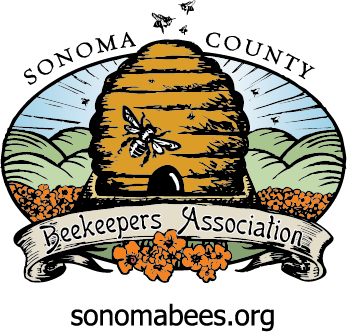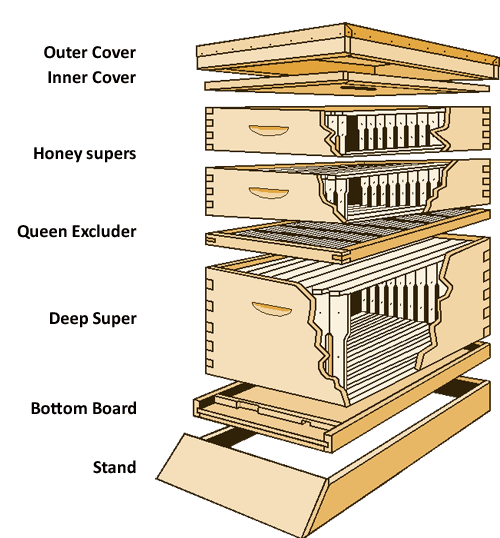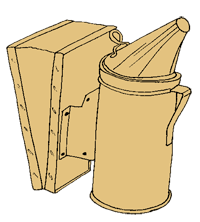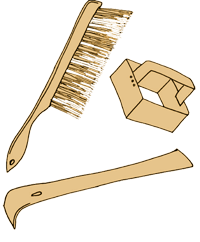 | sonoma county beekeepers association | Click blue icon to Login |
beekeeping basics

The following is offered as a very basic introduction to the complex world of beekeeping. It attempts to present foundational knowledge of items such as:
1. Beekeeping Equipment
2. Sourcing Bees
3. Apiary Management
4. Rules and Regulations
5. Pests and Diseases
6. Honey and Other Bee Products
7. Queens
This is at best a rudimentary primer and any beekeeper should do their own due diligence before making significant investments of time, energy, or finances. SCBA is comprised of many knowledgeable beekeepers who love to problem solve and share information, and we offer our members a full library of books, DVDs, and so forth for personal education.
1. Beekeeping Equipment
The Hive
There are several different types of hives you can acquire, though the Langstroth is most common. It is a good idea to research and talk with other beekeepers before deciding which to choose. Investing in an apiary can get expensive and it is a good idea to start small and grow slowly. Beehives can be bought or made - if you are a skilled woodworker you can find free plans all over the web. The following information and most references on this site are for using a Langstroth hive.
Screened/Bottom Board - the bottom board is a stand made of wood where the hive rests. Some are solid while others have a screen in the floor to allow debris to fall to a tray or the ground underneath. Bottom boards should be set off the ground on a stand such as bricks or concrete blocks.
Hive body or brood chamber - a box usually called a "super" which holds 10 frames of comb.
Frames and foundation - wooden frames are used to provide the bees with a guide for drawing out straight comb. Foundation is optional and is imprinted with the shape of hexagonal cells; if no foundation is used, the bees will draw out their own comb to fill the frame.
Follower boards - solid wooden boards used on the outsides of the frames, allowing the beekeeper to adjust the number of frames used in a super. It is argued that follower boards simplify manipulating the hive and provide better air circulation.
Queen excluder - another optional item, a queen excluder is a metal screen used in order to keep the queen in the brood nest and out of the honey supers.
Honey supers - these are boxes complete with frames wherein bees store excess honey.
Inner cover - bees will be prevented from attaching comb to outer cover.
Outer cover - serves as protection from the weather.
You can buy all of this and other equipment from a local bee equipment supplier. Hive body parts come in kits or preassembled; again, if you have woodworking talents it could be more cost effective to build yourself.

Additional/optional hive parts might include:
Entrance reducers - are wooden blocks that partially close hive entrances to prevent robbing or entrance of mice. Robbing screens allow continuous ventilation of the hive while prohibiting entry of robbing bees.
Feeders - There are different reasons you might have to feed your bees, as well as different kinds of feeders to use. A top feeder is a box with trays in it to hold syrup and fits on top of a deep super in the stack of your hive. There are also entrance feeders, where you place a mason jar with syrup into a plastic holder allowing the syrup to drip.
Nuc (short for Nucleus) - A "nuc" or nuc box, is a smaller version of a normal hive designed to hold fewer frames. It is intended to contain a smaller number of bees, and a smaller space makes it easier for the bees to manage the temperature and humidity of the colony, which is vital for brood rearing.
Smoker - Most beekeepers use a smoker as a way to calm their bees before working with them. A smoker is a device designed to emit smoke by using some type of organic fuel such as cotton batting, twine, burlap, pine needles, corrugated cardboard, rotten wood, or dried grasses.
Smoking the bees initiates a feeding response causing preparation to possibly leave the hive due to a fire. The smoke also masks the alarm pheromone released by the colony's guard bees when the hive is opened and manipulated.

Hive Tool - A hive tool is essential to the beekeeper as it allows them to remove and pry woodwork sealed with propolis from sections of the Langstroth hive. The hive tool has two parts: the wedge or blade and the handle. Hive tools are often fitted with brightly-colored, plastic-coated handles to help the beekeeper locate the hive tool while working.

Protective clothing - A veil is the minimum protection required when working with bees. There are some good jacket/veil options. For the best protection, full bee suits are recommended. Remember, white or light colored clothing are best when working with bees.

Photo by Thea Vierling
Gloves - There are a variety of gloves that can be can be used. Some beekeepers use rubber kitchen gloves, others use leather gloves, while some more experienced beekeepers choose not to use gloves at all. Try out different ones to see what works best for you.
Of course as in any industry, there is a large variety of specialty items that are used by beekeepers. Once you get started your beekeeping accessories will grow.
2. Where to get bees?
Once you've decided to start beekeeping, you'll have to obtain bees for your hives. Methods of getting bees differ among beekeepers and what works for one may not work for another. We encourage anyone interested in starting a beehive to attend one of our monthly meetings, or attending an SCBA event and talk with local beekeepers to get advice.
Package Bees - Most beekeepers favor getting bees locally if at all possible. If you are going to order packaged bees do it EARLY! Packaged bees come annually, between April-June, so plan accordingly.
Beekeeping suppliers sell bees by the pound; a three-pound package contains between 10,000 to 12,000 bees. Your package should contain mostly workers, as well as drones and of course a queen.
Nucs, or Nucleus Colonies, are small honey bee colonies created from larger colonies. The term refers both to the smaller size box and the colony of honey bees within. The name is derived from the fact that a nuc hive is centered around a queen - the nucleus of the honey bee colony.
Nucs are better for a new beekeeper as the bees have already established the colony with their queen, unlike packaged bees who start building their colony the day you put them in your hive. In a nuc you should receive a box with frames of brood, nectar, pollen, and honey, as well as worker and drone bees and their queen.
Attracting swarms - Some beekeepers set up hives to specifically attract wild bees. There are a wide range of different methods used, and none that every beekeeper will agree upon. Old empty brood comb seems to be a great attractant.
Catching swarms - Experienced beekeepers are called upon to catch or remove bee swarms from unwanted areas. SCBA has a list provided as a public resource for removal of swarms. It is suggested that inexperienced beekeepers mentor with someone that has collected several swarms of bees.
3. Apiary Management
Place your apiary near an abundant source of nectar and pollen. If you haven't already, plan to plant forage for your bees throughout the seasons. In town, ornamental trees and plants usually provide ample sources of both. Ornamental plants in cities provide for an extended honey flow.
A good supply of clean water within a quarter mile of the hives is essential. The backyard apiary may need to have a water source provided if there are no bodies of water close by. Bees go to the nearest water source. A shallow pan filled with water and with rocks for the bees to rest upon is an excellent addition to your apiary. Providing a water source of this kind will help keep the bees out of your neighbor's yards.
The apiary should face southeast or south with a windbreak behind it. The location should be well drained. The south face of a hillside is ideal, but bees will adapt to less-than-ideal locations.
Deciduous trees that shade the colony in summer afternoons and allow the sun to penetrate in winter are desirable. Place the apiary near an all-weather road because you will need to access the hive in all kinds of weather. A platform on the roof of a house or other building is a good place to keep hives in town.
4. Government and Private Regulations, Restrictions, and Risks
There are a myriad of governmental and private regulations and restrictions, as well as potential legal issues, regarding beekeeping, and it would be literally impossible to describe or summarize them all. And even if we could summarize them today, they are dynamic and constantly changing, and will be different tomorrow. That being said, every beekeeper is responsible to be aware of the legal implications of his or her beekeeping activities. If you plan to sell bees or bee products, there can be additional requirements or limits on operating a business from the property as well as applicable food laws. In addition to paying attention to legal requirements, a beekeeper can minimize problems by being a good beekeeper and using some common sense – make sure your bees have access to water on your property and do not need to go over to the neighbor’s garden fountain!
5. Pests & Disease
Generally bees take care of themselves, but ...
As a beekeeper, you must be knowledgeable about the various diseases affecting your bees such as American foul brood, and pests like tracheal and Varroa mites. It is important to know how to prevent or reduce mite population inside the hive.
Educate yourself and be aware of the effects of treatments you may use such as pesticides or fungicides. Some beekeepers have a more natural way of keeping bees, honoring the theory of "survival of the fittest." Others help their bees along with natural or organic solutions. Reading the archives of The Extractor, you will find a wealth of topics and solutions for various pests & diseases.
A beekeeper should be knowledgeable of the following diseases and pests:
American Foulbrood - (AFB) is a bacterial disease of larvae and pupae. The bacteria form highly persistent spores that can be spread by adult bees and contaminated equipment. Infected larvae change color from a healthy pearly white to dark brown and die after they are capped. Cappings of dead brood sink inward and often are perforated. Check for AFB by thrusting a small stick or toothpick into the dead brood, mixing it, then withdrawing the mass. Brood killed by AFB will be stringy and rope out about inch.
European Foulbrood - (EFB) is a bacterial disease of larvae. Unlike with AFB, larvae infected with EFB die before they are capped. Infected larvae are twisted in the bottoms of their cells, change to a creamy color and have a smooth "melted" appearance. Because EFB bacteria do not form persistent spores, this disease is not as dangerous as AFB. Colonies with EFB will sometimes recover on their own after a good nectar flow begins.
Chalkbrood - is a fungal disease of larvae. Infected larvae turn a chalky white color, become hard then turn black. Chalkbrood is most frequent during damp conditions in early spring. Colonies usually recover on their own.
Nosema - is a widespread protozoan disease of adult bees. In spring, infected colonies build up very slowly or not at all. Bees appear weak and may crawl around the front of the hive. Discourage nosema by selecting hive sites with good air flow. Damp, cold conditions seem to encourage this disease.
Wax Moths - are a notorious pest of beekeeping equipment. Adult moths lay eggs near wax combs, then their larvae hatch and begin burrowing through the combs to eat debris in the cells. Moth larvae ruin combs and plaster them with webbing and feces. Honey bees are usually very good at protecting their colonies from moth larvae. If moth damage is found in a colony, there was some other problem (usually queen loss) that weakened the colony first. Moth damage is most common in stored supers of comb.
Tracheal Mites - These microscopic mites enter the tracheae (breathing tubes) of young bees. Inside the tracheae, mites block air exchange and pierce the walls of the tubes to suck blood. Symptoms resemble those of nosema. Bees become weak, crawl at the hive entrance and sometimes uncouple their wings so that all four wings are visible. Colony death rates are highest during winter and early spring. If you suspect tracheal mites, see your county Extension agent for help in diagnosing the disease.
Varroa Mites - These mites are about the size of a pin head and are copper in color. Female mites cling to adult bees and suck their blood. Females then enter a bee brood cell and produce several offspring which, in turn, suck the blood of the developing bee. Infested colonies almost always die within three to four years unless they are treated.
Colony Collapse Disorder (CCD) has been making the rounds in the news for some time now. Notable characteristics of CCD are a presence of honey and pollen within the failed hive coupled with a stark lack of quantities of dead bees in the immediate vicinity. One might normally expect a fair number of dead bees in and around a failed hive, robbing may have occurred, and if the bees had absconded (which would explain a lack of carcasses) they should have raided their food stores thereby leaving the hive empty.
Research investigators haven't yet pinpointed the cause of CCD but tentatively believe it is contagious. If you suspect a colony has suffered from CCD, the recommendation is to NOT USE THE BEE STORES IN OTHER COLONIES, and to flame scorch your equipment before re-use. By extension, if you have a particularly weak colony, you may want to rethink whether you combine it with another stronger colony since you risk spreading the problem to your healthy one. Combining two weak colonies poses the same risks, but if the problem at hand is a result of hardship on the bees (which would be identifiable by low honey stores and/or poor or no brood), these risks may be justifiable on the basis that you may otherwise lose both colonies.
6. Honey and other bee products
Honey
Honey is a sweet food made by insects using nectar from flowers. The variety produced by honey bees is the one most commonly referred to and is the type of honey collected by beekeepers and consumed by humans. Honey produced by other bees and insects has distinctly different properties.
Honey bees form nectar into honey and store it as a primary food source in wax honeycomb cells inside the beehive. Common beekeeping practice encourages overproduction of honey so that the excess can be taken without endangering the bee colony.
Flavors of honey vary based on the nectar source, and various types and grades of honey are available. Honey is also used in various medicinal traditions to treat ailments.
It is time to harvest your honey when you inspect the hive and find the supers full of capped honeycomb. The bees conveniently let you know when it is finished by capping it. It is important to assure the bees have enough honey for themselves to survive the winter (called "overwintering"). A hive needs approximately sixty pounds of honey to overwinter; one - 'deep' frame, or two 'shallow' frames equals approximately six lbs.
Removing frames or a whole honey super from the hive can be a task. As in all aspects of beekeeping there are different methods for harvesting honey. First the bees must be removed from the frames that are to be harvested; (!) caution - they can become aggressive - it is their honey and they will fight for it.
Honey is sold under many names, most commonly qualified as "extracted" honey (bottled, liquid honey that has been extracted from the combs),"comb" honey (honey still in its natural comb), and "chunk" honey (a bottled combination of extracted and comb).
For the hobbyist beekeeper honey extracting equipment can be expensive, fortunately SCBA members have access to shared equipment. Used equipment is often available at significant savings. These are the basic tools and procedures for extracting honey:
Uncapping knife - A heated knife for slicing off the cappings from combs of honey.
Uncapping tank - A container for receiving the cappings. Wet cappings fall onto a screen, and honey drips through to the bottom of the tank and out a spigot.
Extractor - A drum containing a rotating wire basket. Uncapped combs are placed in the basket and the basket is turned by hand or by motor. Honey is flung out of the combs onto the sides of the tank and drains through a spigot.
Strainer - A mesh of coarse screen or cloth directly under the extractor spigot. This filters out large debris such as wax and dead bees.
Storage tank - A large tank with a spigot, or "honey gate," at the bottom. As honey settles in the tank, air bubbles and small debris rise to the top and can be skimmed off, allowing honey that is bottled from the honey gate to be clear and attractive.
Rendering Beeswax
Wax cappings are a valuable by-product of extracting. After cappings have dripped dry, wash them in water to remove all honey. Melt the cappings, strain the wax through cheesecloth and pour it into bread pans or a similar mold. Once enough wax has been collected, supply companies can render your beeswax bricks into new foundation or use the wax for cosmetics or candles.
Trapping Pollen
Traps for collecting pollen pellets from legs of honey bees have been designed to trap pollen reserves. These traps vary greatly in size, appearance, and method of installation on the hive. Each has some feature that makes it particularly adaptable for a specific purpose. All traps, however, have two basic elements: (1) a grid through which pollen-carrying bees must crawl to separate the pollen pellets from the bees' legs, and (2) a container to store these pellets.
Propolis
Bees have used propolis for millions of years and humans have used it for thousands. Propolis is a vegetable mastic made by honeybees from resins collected from the bark and sticky buds of a variety of trees and balsamic plants. Gathered by the oldest bees, the resins are brought back to the hive and mixed with some wax and salivary secretions before being used to sterilize the hive against infection.
Also called "bee glue," propolis is used by the bees to varnish the hive interior, seal cracks, and cement things together. Propolis reinforces and protects the hive. Beekeepers can collect propolis by using a particular tool wherein after the summer honey harvest a specialized screen is placed on the hive. The bees do not like drafts and quickly fill the holes with propolis. The screens are then removed to harvest the propolis.
Containing resinous compounds and balms, beeswax, aromatic essential oils, and bee pollen, propolis is the substance responsible for neutralizing any bacteria, fungi or virus that enters the hive. It is one of the most powerful antibiotics found in nature. It is rich in amino acids and trace elements, and has a high vitamin content including at least thirty-eight valuable bioflavonoids. Because of the high levels of bioflavonoids in propolis, the product has a high antioxidant value. A large number of studies have shown propolis to be highly antimicrobial. It is found to have an inhibitory affect on at least twenty-one species of bacteria, nine species of fungi, three species of protozoa (including Giardia), and a wide range of viruses.
7. Queens
It is common procedure for beekeepers to improve their colonies by "re-queening" colonies that are not performing well. Common desirable features a beekeeper looks for in the queen's offspring are gentleness, good collectors of honey or pollen, illness and pest resistance, decreased swarming, minimal propolis use, effective pollination, or a desired body color.
Marking Queens
International Queen Marking Color Code Year Ending in:
White (or gray) 1 or 6
Yellow 2 or 7
Red 3 or 8
Green 4 or 9
Blue 5 or 0
Because the queen is the source of all worker honey bees in the colony, it is important that the beekeeper be sure the queen is the one originally placed in the honey bee colony. It is nearly impossible to determine that a specific queen has been lost when the queen hasn't been given a unique identifying mark.
Common practice is to mark the queen with a small spot of paint on her back (thorax). A color code exists within the beekeeping industry to indicate the year the queen was introduced (see above). Model car paint may be used to mark the queen. The identifying mark should be small so that it does not cover any other part of the queen. A 1/16" stick, lightly dipped in paint, is a good applicator.
Ordinarily, queens are marked before being introduced, but they can be marked at any time. Paint should be given ample time to dry before the queen is released into the honey bee colony. In fact, queens might be purchased already marked by the queen producer.
Introducing Queen Bees
When specific requirements are not met the resident honey bees may reject or even kill a newly introduced queen. Through the years, many procedures for introducing queens have been published. Regretfully, no specific procedure has been accepted universally as the best for all occasions. Most of the common procedures require an introductory period of about three days.
Suggestions for Introducing New Queens
- Be absolutely certain the honey bee colony is queenless and that any developing queen cells have been destroyed.
- Allow the honey bee colony to stay queenless for a day or so.
- If possible, allow the queen to be caged within the honey bee colony for about two days.
- To release the queen, place the cage between the frames with the screen side down and with the candy plug exposed near the vicinity of young honey bees and brood. After two days, remove the cage as soon as possible to prevent burr comb from being produced in the space around the queen's cage.
- If the queen is to be manually released, watch the surrounding honey bees to determine if they're clinging tightly to the queen cage. If they're showing aggressive behavior, do not release the queen until the surrounding workers act passively toward the caged queen.
- After releasing the new queen manually, watch the surrounding workers to see if they react hostilely to the new queen as she explores the comb on which she was released.
- When possible, do not open the hive again until the queen has had time to develop a brood nest of her own (about seven days).
For more information please refer to our Best Management Practices.
Hopefully this information has been helpful. No matter your level of experience, it can always be useful to have a 'bee buddy' or a local mentor with whom to compare practices and colonies.